|
Chastleton House, near Moreton-in-Marsh, was built between 1607 and 1612 by Walter Jones, a lawyer. An imposing four-storeyed building of mellow Cotswold stone, it is now owned by the National Trust.
We were greeted by perhaps the friendliest bunch of National Trust stewards I have ever met. All of them were helpful and as enthusiastic about the house as I became. You enter through a porch which seems strangely off centre, and when you enter you discover why: you’re in a screened passage which leads to the hall - all rather old-fashioned for 1607. Hanging around the walls is a collection of 17th century portraits, all of which seemed rather crudely painted (but maybe that’s because we had visited the Van Dyck exhibition just the day before). Don’t be fooled by all the apparently 17th century portraits in the house - many of them are the result of a 19th century craze for ‘acquiring’ ancestors.
The carved panelling throughout Chastleton is magnificent, although not all of it is 17th century. Deeply-cut acanthus leaves and little faces remain in my memory, but I was surprised to discover that it isn’t thought that any of the oak panels were originally painted. As you delve further into the house a myriad of moulded plaster friezes and ceilings assault your senses, until you reach the Great Chamber where we marvelled at the forest of great bosses which seem to imitate the great wooden bosses of Tudor great halls. Feeling all this grandeur couldn’t be beaten, we continued through the house until we came upon the Long Gallery where the huge, arched ceiling took our breath away. Not as ornate as the Great Chamber but so-o-o ... much bigger. As we creaked across the oak floorboards it felt as if we were on board ship - the steward told us that when the wind and rain lash this room from the outside it feels as if it is a ship at sea.
The real glory of Chastleton is the textiles. Some of the tapestries, hangings and covers are 17th century or earlier and have hung in their present positions since the house was built. In places, where the light hasn’t reached the fabric, the colours glow. On an upper floor landing a panel of striped fabric known as Domix shows the depth of colour in 17th century fabrics. Stripes of yellow, white, red, blue and green break up wider green stripes, sprigged with yellow flowers. Behind the bed in the Fettiplace Room the rich greens and yellows of the Flanders tapestries look fresh and new and really give the impression of how this room must have looked 350 years ago. Yet again the house continues to surprise, because around the walls in the small closet off this room hang the most amazing pieces of ‘flame stitch’ work. These are thought to originally have been bed hangings. Most are dark and discoloured, but a small strip on one wall is bright and clean, with pinks, greens, blues and yellows giving a tantalising glimpse of how bright these hangings once were.
The joys of Chastleton are too numerous to mention here. It isn’t a ‘smart’ National Trust house. Its decay has been stopped and stabilised, but no renewal has taken place. However we came away stunned by the magnificence of it all.
By Eve Bacon, Sir Henry Bard’s Regiment, The Sealed Knot. From Orders of the Day Vol 32-1, Jan-Feb 2000.
Article ©The Sealed Knot Ltd, Nottingham, U.K.
|




